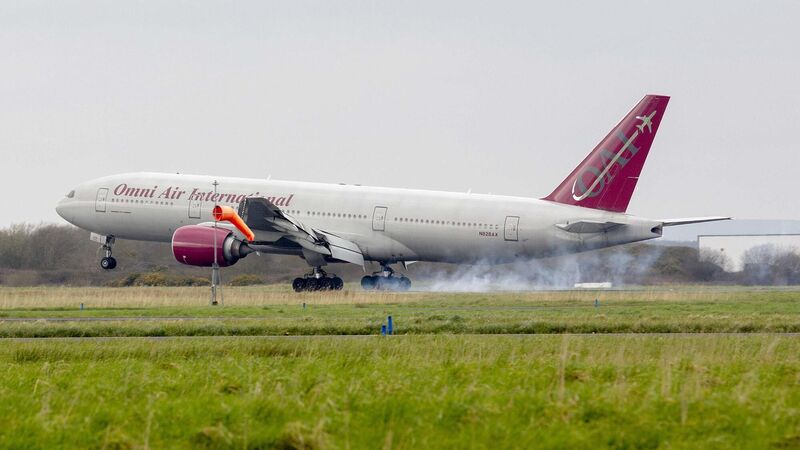Aborted high-speed take-off identified as cause of aircraft fire at Shannon

A report by the Air Accident Investigation Unit into the incident involving an Omni Air International plane carrying US troops at Shannon Airport on August 15, 2019, found a fire had broken out in the main landing gear area of the Boeing 767-33A aircraft as it returned to a parking stand while taxiing from the runway. Picture: Press 22
An aborted, high-speed take-off by a plane carrying US military personnel is suspected of causing a fire on the aircraft which led to a major emergency at Shannon Airport two years ago, an official investigation has found.
A report by the Air Accident Investigation Unit into the incident involving an Omni Air International plane carrying US troops at Shannon Airport on August 15, 2019, found a fire had broken out in the main landing gear area of the Boeing 767-33A aircraft as it returned to a parking stand while taxiing from the runway.
One soldier suffered a minor injury during the evacuation of the plane, which had 10 crew and 145 passengers on board, while the fire was quickly extinguished by the airport’s fire and rescue service.
AAIU inspectors said an examination of the wheels, brakes and flight recorded data found no identifiable cause of the fire.
However, an official AAIU report said it was probable the fire was ignited by the braking system overheating due to a combination of an aborted take-off at high speed with a lengthy period of taxiing where brakes were also being used.
The report revealed the pilot had decided to abandon take-off after hearing an unusual noise in the cockpit, which grew louder as the aircraft moved down the runway.
The pilot told inspectors he thought a window in the cockpit might not have been properly closed.
The flight crew then decided to return to the parking stand to carry out checks and allow up to 40 minutes to cool the aircraft’s brakes before it could attempt another take-off.
The AAIU said air traffic controllers noticed smoke coming from the left side of the plane’s main landing gear before going on fire.
The pilot immediately stopped the aircraft and shut down the engines, while initiating an evacuation from the right side of the plane.
All passengers and cabin crew were evacuated from the aircraft within four minutes of an emergency being declared and emergency slides being activated.
Flight data showed the aircraft was travelling at an airspeed of 152 knots when the brakes were applied to abort the take-off, contrary to the view of the flight crew who believed it was around 120 knots.
The estimated speed was important for determining the amount of cooling time needed before another take-off could be tried, the AAIU noted.
It said the Omni Air flight crew might have adopted “a more cautious approach” when taxiing the aircraft if they had been aware of aborting take-off at a higher speed.
Inspectors also observed that Boeing’s training manual advises flight crews that an open flight deck window does not warrant a high-speed aborted take-off, although it recognised that noise from an open window could interfere with crew communications.
The emergency led to the runway at Shannon Airport being closed and flights suspended for several hours.











